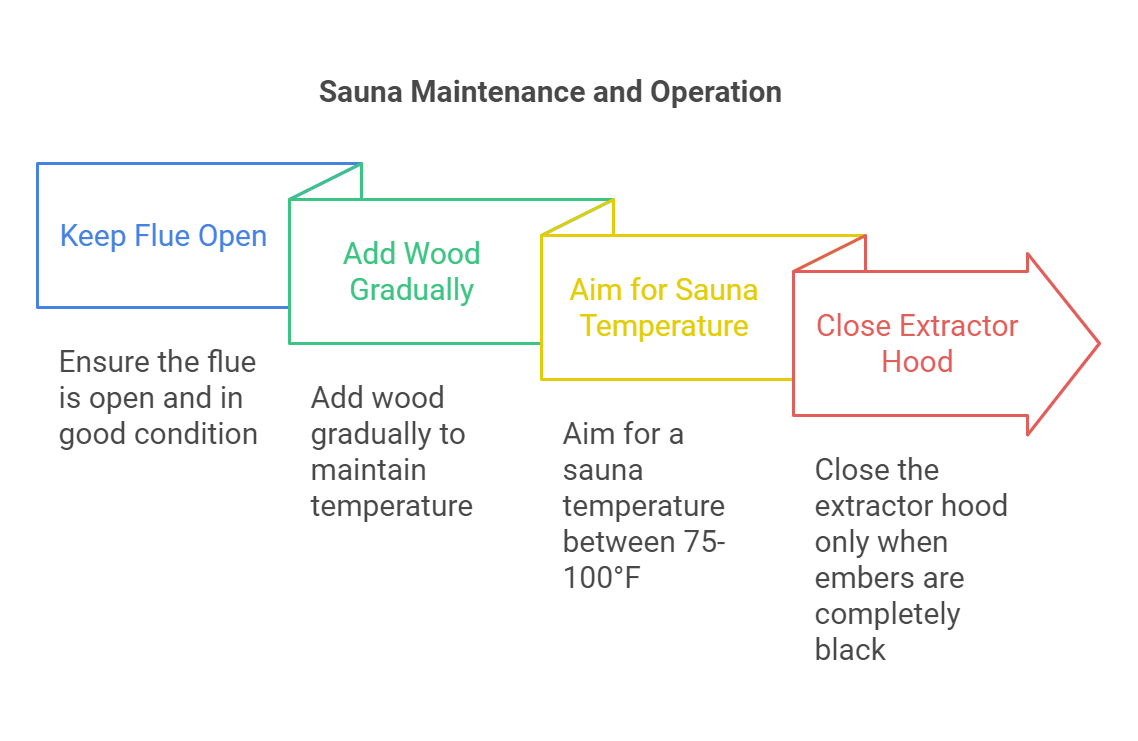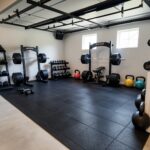Ever felt like you enter a different world when you step into a wood-fired sauna? The mix of heat, aroma, and tradition is unique. This guide will teach you how to use a wood fired sauna safely and well, focusing on heating and ventilation.
Wood-fired saunas are a big part of Finnish culture. They do more than just warm you up. They help prevent colds and flu and boost heart health. These saunas can get as hot as 200°F, offering a deep yet refreshing experience.
Good ventilation is key in a wood fired sauna. It gets rid of extra CO2, moisture, and bad stuff, making sure you have a safe and fun time. Sadly, 90% of saunas in North America are not good because they don’t ventilate well. This guide will help you avoid mistakes and make your sauna perfect.
If you’re thinking about building an outdoor sauna or just want to enjoy one safely, knowing the basics is important. We’ll talk about picking the right wood, keeping temperatures between 160-195°F, and more. You’ll learn how to get the most out of your sauna time.
Table of Contents
Key Takeaways
- Wood-fired saunas offer unique health benefits and a traditional experience
- Proper ventilation is critical for safety and enjoyment
- Ideal sauna temperatures range from 160-195°F
- Heating a wood-fired sauna typically takes 45-60 minutes
- Regular maintenance ensures longevity and optimal performance
Introduction to Wood Fired Saunas
Wood fired saunas offer a unique and traditional bathing experience. They use wood burning stoves to heat rocks and create a soothing atmosphere. Unlike infrared heating, wood fired saunas provide intense heat that can reach up to 210 degrees Fahrenheit.
What is a wood fired sauna?
A wood fired sauna is heated by burning wood in a special stove. These saunas can be built as standalone structures or integrated into existing buildings. Many people choose a barrel sauna design for its efficient heat distribution and quick heating time. Wood fired saunas typically heat up faster than electric ones, reaching maximum heat levels in about 45 minutes.
Benefits of wood burning saunas
Wood burning saunas offer numerous health benefits. Regular sauna use can reduce the risk of catching a cold or flu by 30%. The intense heat promotes sweating, which helps detoxify the body and improve circulation. Wood fired saunas also provide a more authentic experience compared to infrared heating, with temperatures ranging from 160-210°F.
Traditional vs. modern wood fired saunas
Traditional wood fired saunas have been around for over 2000 years. Modern versions may feature updated designs and materials, but the basic principle remains the same. Both types require proper ventilation through a chimney. Sauna installation for wood fired models is often simpler than electric ones, as they don’t need electricity. This makes them ideal for outdoor settings and off-grid living.
| Feature | Traditional Wood Fired Sauna | Modern Wood Fired Sauna |
|---|---|---|
| Design | Basic, rustic | Updated, sleek |
| Materials | Natural wood | Various, including composite materials |
| Heating Time | 45-60 minutes | 30-45 minutes |
| Temperature Range | 160-210°F | 160-200°F |
Choosing the Right Wood Burning Sauna Stove
Finding the perfect wood burning stove is key to a great sauna. It makes your sauna cozy and connects you with nature. Think about your sauna’s size and layout to pick the best stove.
For saunas up to 16 cubic meters, the Aito 16 is a top pick. Saunas between 10-20 cubic meters do well with the Aito 20 or its water tank version. The Aito 24 is best for spaces up to 24 cubic meters. Saunas with lots of glass or little insulation might need more heat.
Wood burning stoves have special benefits over electric ones. They heat naturally and give a cozy scent. Wood-fired saunas are great for outdoor use and are eco-friendly with sustainable wood.
Don’t forget about safety accessories like heat shielding kits and installation bases. The type and number of sauna stones also matter. Diabase, Olivine Diabase, Gabbro, or Olivine stones are best, and more stones make the experience softer and more enjoyable.
| Stove Model | Sauna Capacity (m³) | Special Features |
|---|---|---|
| Aito 16 | 8-16 | Compact design |
| Aito 20 | 10-20 | Versatile for medium saunas |
| Aito 24 | 12-24 | High capacity for large spaces |
By thinking about these points, you’ll create the ideal sauna. The right stove does more than just heat; it makes the whole sauna experience better.
Preparing Your Wood Fired Sauna
Getting your wood fired sauna ready is key for a safe and enjoyable experience. This process involves picking the right wood, ensuring good airflow, and taking safety steps. Let’s dive into these important tasks for your outdoor sauna.
Selecting the Right Firewood
Choosing the best wood for your sauna stove is crucial. Dry, seasoned hardwoods like oak, maple, or birch work great. They should have 15-20% moisture content for efficient burning. Using the right wood helps your sauna heat up quickly and maintain the right.
Proper Sauna Room Ventilation
Good airflow is vital for a wood fired sauna. Keep the chimney clean and vents open. This helps the fire burn well and keeps the air fresh. Proper ventilation also helps control humidity and prevents mold growth, reducing sauna maintenance needs.

Safety Precautions
Safety comes first in sauna use. Place a fire-resistant mat under the stove. Keep flammable items away from heat sources. Install a thermometer to track temperatures, aiming for 176-194°F. Regular checks of the stove and chimney are key for safe operation.
| Safety Measure | Purpose |
|---|---|
| Fire-resistant mat | Protects floor from heat |
| Thermometer | Monitors safe temperature |
| Regular inspections | Ensures stove and chimney safety |
Lighting and Maintaining the Fire
Lighting and keeping the fire right in your wood-fired sauna is key for a safe and fun time. Choose the right firewood for your sauna installation. Look for seasoned hardwood with 15-20% moisture. This ensures clean burning and keeps the heat longer.
Start the fire about an hour before you plan to use the sauna. Use the upside-down fire building method. Put big logs at the bottom and smaller kindling on top. This way, the fire heats up fast and produces less smoke.
After lighting the fire, open the air lever all the way until the logs start burning. Then, adjust it to about 25% open for better heat control. Watch the smoke color – light gray or “invisible” smoke means the chimney is working well.

For extra comfort, add essential oils like eucalyptus or lavender. Mix with water and pour over heated stones for aromatic steam. Remember, managing the fire well makes your sauna session safe and relaxing.
Wood Fired Sauna Temperature Control
Wood fired saunas offer a unique Finnish sauna experience. Mastering temperature control is key to enjoying sauna benefits. Let’s explore how to achieve the perfect heat in your wood-burning sauna.
Optimal Temperature Range
Wood-burning sauna stoves can reach impressive temperatures. This creates intense heat for your sauna sessions. Most users prefer a range of 160-194°F (71-90°C).
Beginners should start at lower temperatures, gradually increasing over time. It’s wise to limit sessions to 15-20 minutes, especially for experienced users.
| User Level | Recommended Temperature | Session Duration |
|---|---|---|
| Beginner | 140-160°F (60-71°C) | 5-10 minutes |
| Intermediate | 160-180°F (71-82°C) | 10-15 minutes |
| Experienced | 180-194°F (82-90°C) | 15-20 minutes |
Using the Damper for Heat Regulation
Control the heat in your Finnish sauna by adjusting the firebox door and ash pan opening. These components act as dampers, regulating airflow and thus temperature. Opening them increases air circulation and heat, while closing them slows the burn and lowers temperature.
Adding Water for Steam (Löyly)
Enhance your sauna experience by adding water to the heated stones, creating steam known as Löyly. This practice not only increases humidity but also intensifies the perceived heat, maximizing sauna benefits. For optimal heat distribution, arrange stones from largest at the bottom to smallest at the top.
“The essence of a Finnish sauna lies in the perfect balance of heat and steam, creating a cleansing and rejuvenating experience for both body and mind.”
Remember, it typically takes 30-60 minutes for a wood-burning sauna to reach the desired temperature. Plan accordingly to fully enjoy your sauna session.
Sauna Session Best Practices
Learning the best ways to use a sauna can make your experience better and increase sauna benefits. Start by taking a quick shower before you go in. Begin with 10-15 minute sessions at 160-180°F, then increase the time as you get used to it. Remember to drink water while you’re in the sauna, as you can lose up to 2% of your body fluids through sweat.

Don’t drink alcohol while in the sauna. Take breaks to cool down by using cool showers or sitting in cooler spots. If you start to feel uncomfortable, get out. After your sauna time, take a cool shower to finish off. For the best health benefits, use the sauna 4-7 times a week.
“Wood burning saunas can attain temperatures up to 200°F, providing a unique, immersive experience.”
While infrared saunas are popular, traditional wood-fired saunas have their own benefits. They can get hotter and offer a more authentic feel. The smell of burning wood also adds to the relaxing experience.
| Sauna Type | Temperature Range | Unique Features |
|---|---|---|
| Traditional Wood-Fired | 160-195°F | Natural wood scent, higher heat capacity |
| Modern Wood-Fired | 160-210°F | Faster heating, better temperature control |
| Infrared | 120-150°F | Direct body heating, lower ambient temperature |
It’s important to have good ventilation when using wood-burning saunas. Regular upkeep, like cleaning the chimney once a year, keeps it safe and working well. By following these tips, you’ll have a great sauna experience and enjoy many health benefits.
Cleaning and Maintaining Your Wood Fired Sauna
Keeping your wood fired sauna clean and safe is key. Regular care makes it last longer and work better. Let’s look at the important parts of sauna upkeep.
Post-session Maintenance
Wipe down benches and surfaces with a mild soap after each use. This keeps your sauna clean and fresh. Sauna sessions usually last 10-20 minutes, with breaks in between.
Regular Cleaning Routines
Do a deep clean every month. Sweep, vacuum, and mop when it’s cool. For hard stains, sand the wood gently. Good air flow helps stop mold.
Long-term Maintenance Tips
Check and treat the wood often, especially if it’s outside. Look at sauna stones monthly and replace them yearly if you use them a lot. Check the wiring and heating elements for safety. Clean the chimney at least once a year to avoid fires.
| Maintenance Task | Frequency | Importance |
|---|---|---|
| Wipe surfaces | After each use | Prevents buildup |
| Deep clean | Monthly | Maintains hygiene |
| Check sauna stones | Monthly | Ensures efficiency |
| Clean chimney | Yearly | Prevents fire hazards |
Don’t forget to clean sauna accessories like thermometers and water buckets. By following these tips, your wood fired sauna will stay in great shape for many years.
Ventilation Strategies for Wood Fired Saunas
Proper ventilation is key for wood-fired saunas. It keeps the sauna safe and enjoyable by removing CO2, humidity, and contaminants. We’ll look at downdraft and circulating ventilation options.
Importance of Proper Ventilation
Good ventilation is vital in wood-fired saunas. It keeps air quality and temperature in check. Outside air has 20.96% O2 and 380 ppm CO2. Saunas aim for 550 ppm CO2 for better health.
Downdraft Ventilation Option
Downdraft ventilation is a favorite in sauna design. It uses fresh air above the heater and natural exhaust in the opposite corner. This setup ensures even heat and air flow.
Circulating Ventilation Option
Circulating ventilation is another good choice. It uses fresh air below benches and natural exhaust in the opposite corner. This method keeps air moving and temperature steady.
| Ventilation Type | Fresh Air Supply | Exhaust Location | Benefits |
|---|---|---|---|
| Downdraft | Above heater | Opposite corner | Even heat distribution |
| Circulating | Below benches | Opposite corner | Consistent air quality |
Both downdraft and circulating ventilation aim for a safe, enjoyable sauna experience. They help control air quality and temperature. When designing or installing your sauna, consider these options for the best atmosphere.
Conclusion
Wood fired saunas give a unique and traditional experience that many love. They can get as hot as 200°F. These outdoor saunas have a rustic feel and are cheaper to heat. The act of preparing firewood and tending to the stove can be calming, adding to the sauna’s benefits.
It’s important to have good ventilation, maintenance, and safety when using a wood fired sauna. Choosing the right stove and firewood, and following best practices for heating and temperature control, are key. Regular cleaning and upkeep are crucial for safety and longevity. Also, having good ventilation helps maximize the sauna’s health benefits.
Both wood fired and electric saunas have their own benefits. Wood fired models offer a real experience and are great for off-grid places. Electric saunas heat up fast and have precise temperature control. The choice depends on what you prefer, where you’ll put it, and how much maintenance you’re willing to do. By knowing these things, sauna lovers can find the perfect fit for their wellness goals and lifestyle.







